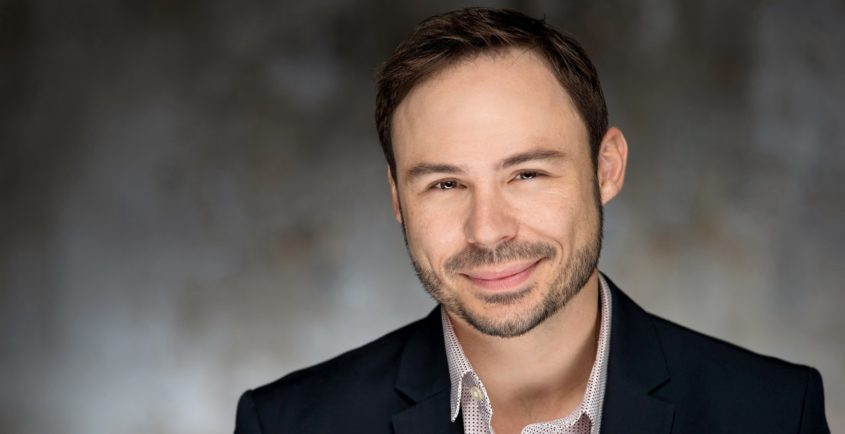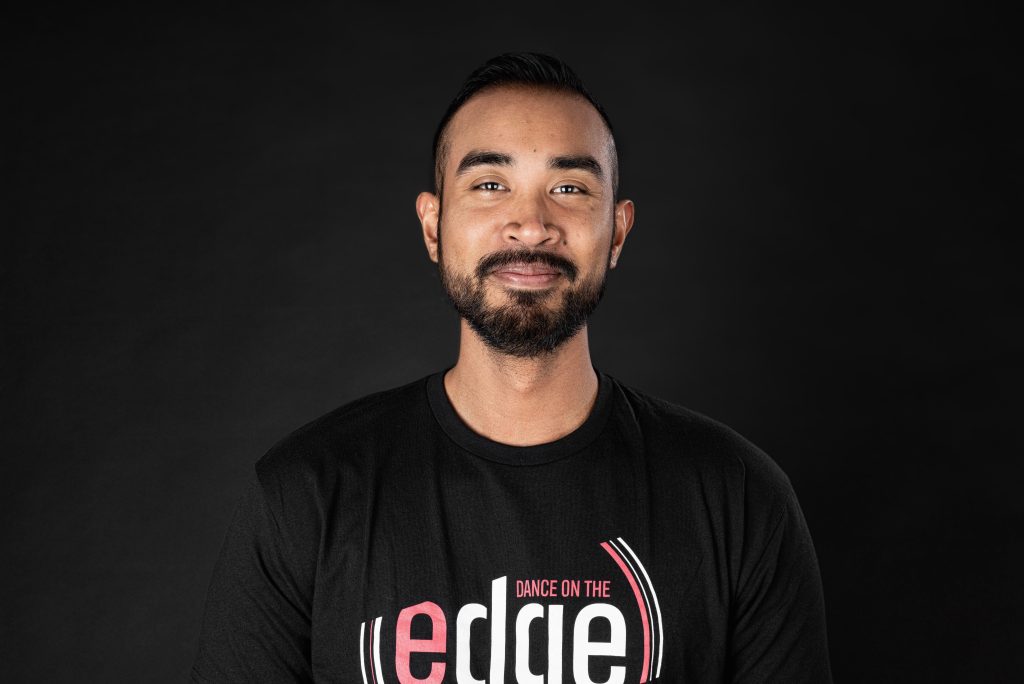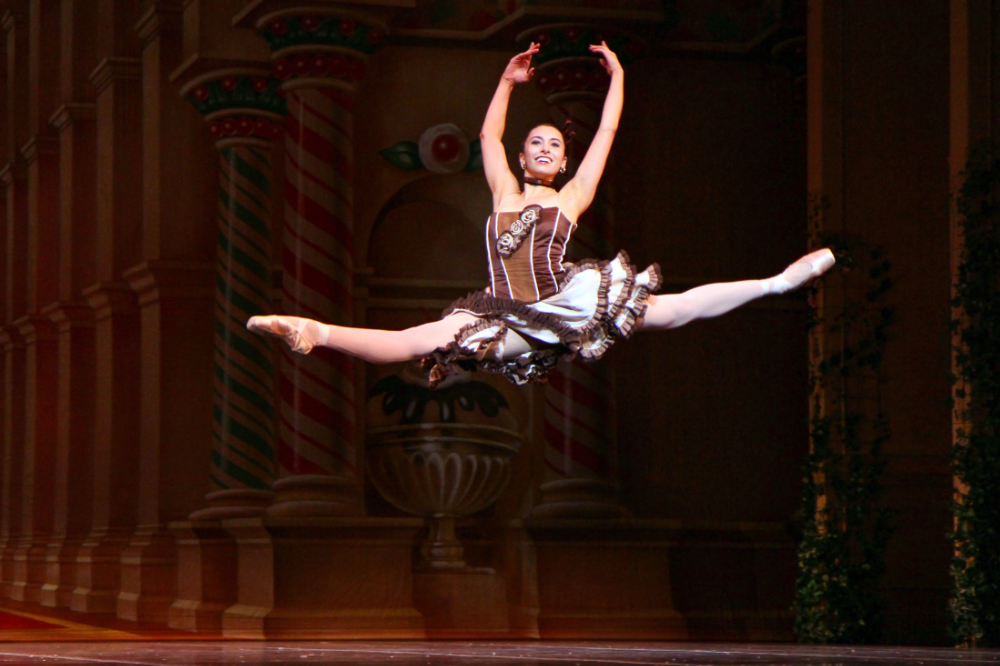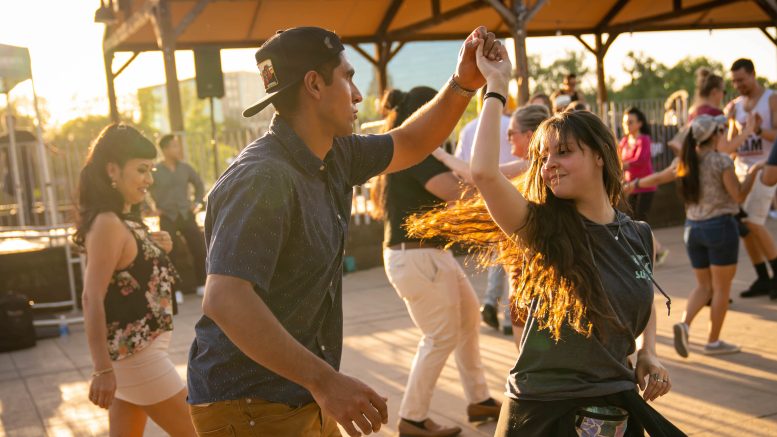By Casey Rafter
Anthony Krutzkamp is the artistic and executive director of the Sacramento Ballet, established in 1954. Sac Ballet is known best for its annual productions of “The Nutcracker,” though it fills its calendar with other classic and contemporary ballets.
Krutzkamp’s start in ballet was with the Cincinnati Ballet at 18, where he rose to the rank of principal dancer. After retiring from dancing from the Kansas City Ballet, he became head of that organization’s Second Company. He took the helm of Sac Ballet in July 2021.
Romi Sunga is the co-founder of Dance On the Edge, a free family event that offers large-group lessons in salsa, bachata, merengue and cumbia. They host a monthly night of lessons in Old Sacramento called “Latin Dance Night At The Waterfront,” where attendees can enjoy one of the cooler parts of Sacramento while moving their hips. The group has expanded to other locations in the Sacramento area.
Sunga, an L.A. native, got his start in latin dance when he joined the Salsa club at Sacramento State.
Having never met before, the two recently convened in a quiet office in the University Union at Sac State to talk about connecting with audiences on a personal level and growing their two worlds of dancers beyond their perceived potential. They got the conversation going first by trading some marketing ideas.
Sunga: With Dance On the Edge, we do a lot of grassroots marketing; not necessarily in the traditional sense of marketing. Social media is where we’re at, so we do a lot of behind the scenes or showing the story of how these events are programmed and developed. That’s how we get a lot of our fan base to come out and support us.
Krutzkamp: That’s really great. We go with the traditional path when it comes to the company. But definitely in the second company, they do some great things: they figured out that spray chalk is actual chalk, which is legal to spray on sidewalks, so you can follow the pointe shoes to our school. You can follow the swan to “Swan Lake.” It’s actually really fun. I was like, “This is really smart. Don’t get arrested.”
Sunga: With the city stuff, I learned to work with the Property Business Improvement District. They’re usually like, “Oh, if you’re going to do some type of promotion and it’s not an obstacle to our people or the residents or businesses, just do it and we’ll give you the paperwork to give you the covering [for] liability’s sake.” They’re down for the simple stuff because, in a placemaking thought process, those chalks you do on the floor, that is something that makes it not just advertising for you, but people who come by who’ve never been to the city wonder, Why is this here? And now they’re taking selfies. We want that to increase tourism.
Krutzkamp: Absolutely. Actually, we’re running out of things to do grassroots-wise sometimes. I’m having trouble getting people past Folsom. Folsom is my ending point for most shows. “Nutcracker,” people drive in from Reno, but the really amazing contemporary shows where people don’t actually know what we do … the causeway might as well be the Mojave Desert.
That’s our big thing. We’ve got to get advertising past those spots, because people will not drive a certain amount. I’ve been reading a lot about [how] we’re a megaregion, but there’s 4 million people within 50 miles. I need to make up to 25. That’s my struggle right now: How do I get people to get in the car and come down?
Sunga: Yeah. Obviously “Nutcracker” has its own prestige, just the name itself, everyone’s aware of it. With the other contemporary stuff, is this new, progressive? … Is Sac Ballet doing modern works now or — ?

Krutzkamp: Modern is a genre, so I will say contemporary. … I like this idea of “made in Sac.” That way, say that piece is amazing and somebody else wants to buy the intellectual property from the choreographer — everything comes from Sacramento: the lighting design, the sets, the costumes. We want everything made here. Plus, it’s much cooler for the artists. [We need to be] more descriptive of how and why, rather than what contemporary is. Maybe people don’t understand.
Sunga: When I say salsa, everyone knows salsa … but when I say bachata, merengue, cumbia, they’re like different styles that fall within the Latin genre. By the way, did you know, for bachata, they used to only be danced in speakeasies; no one was allowed to dance it in public and then it became a common thing in the early 2000s. When we hit them with the story, they’re like, “Whoa, that’s kind of cool.” And now like it’s everywhere; it’s the biggest thing after salsa. You find it all over the world.
Going back to [SacBallet], I really liked that you’re using your own company members as the choreographers and creative ideators. That’s what’s pulling our own people here to Sacramento for Dance On the Edge. We’re using local dancers here and local DJs here and local vendors here. We are doing the modernized version of it, but we’re still paying homage to the originals.
We’ll have people drive down from Chico, come up from Fresno, come from Reno, come from [the] Bay Area for a one night event, and they’ll be dancing from 6-10 p.m. and they leave again.
Krutzkamp: How do you pick your venues?
Sunga: It was by accident — the way we ended up being in Old Sac on the Embarcadero space. Before we officially became Dance On the Edge, our friends were just playing Pokemon Go and they’re like, Hey, what if we just dance out here near the river? This was before we knew anything about permitting, the process of working with the city or the district. They did that event, 20 people showed up. Guerilla marketing through Facebook. And then it went from 20 people to 40 people to 100.
Eventually, I got involved and we need[ed] to cover our liability. That’s how we started an LLC. Now we’re learning the business side.
In terms of the venue, the district director from Downtown Sacramento Partnership in Old Sacramento noticed we were bringing in a lot of foot traffic and that we were one of those scrappy, lean groups that were like, “Yeah, just tell us where we could do something and then we’ll just bring our friends and our people.” And they were like, “Can you try out this space in front of the railroad museum on the street?” And we’re like, “Yeah, we can do that within some type of budget. We’ll just pay for the road closure.” The railroad didn’t like it because there’s too much music vibrations for their stuff inside. There was a concern for some of the historical items there.
That’s when they renovated the entire embarcadero space because it used to be an all wooden platform. So before they even did their ribbon cutting, we got in there as the unofficial or informal first activations there. … We went from Old Sac and then we got in front of the west steps of the Capitol. We got in Midtown near Cantina Alley; we closed up that entire alley space. Then we just started grassroots marketing to get more communities to want to come out.
It was just all from hobby and fun.
Krutzkamp: And it should be.
Sunga: We were just chasing it. We want more. As long as the permitting cost is covered or we can pay for it some way, let’s do it.
Krutzkamp: It’s smart though: The idea that the creative economy is helping you go where you need to go for your venues.
Sunga: Yeah.
Krutzkamp: Because people notice that you’re bringing people somewhere. [You] can have 80 people in front of this restaurant.
Sunga: That’s one of my talking points. Our foot traffic for our Old Sac event is between 1,000 to 1,500 in the span of four hours. We know that, at any given moment, I could count how many people are on the dance floor; it’s gonna be over 300 people there, staying for over two hours.
We didn’t know how to pull statistics, but once we started learning the language that the businesses want to hear or the local city reps want to hear, then they’re more bought-in because they see the tourism benefits and the economic benefits from the storefronts. When we hit them that people drive two-three hours away to get to a one-day event, sometimes on a Friday when you get off work from Chico and and you drive all the way to us to dance for an hour or two then you have to drive back that same night, that’s hardcore. There’s an interest or a commitment to just experiencing the music, experiencing the dance that’s made available to our people.
With the people [we’re] trying to reach, it’s trying to give them that storytelling of how the work has been developed with your artists. And then also telling them: This is how you can actually be part of that too. We let our audience members know we’re just the stage. We’re putting up the backdrop and lighting, but you’re really the one on the stage.

Krutzkamp: There’s the difference: I gotta have people buy into the fact that they’re going to watch someone’s artistry. It’s a story within itself, no matter how avant garde it is, but it’s people buying into the fact that [they’re] going to live vicariously through these artists. Not showing up and being part of the artwork. I mean, you are, but you’re not. You’re there to watch, which is easy. “Nutcracker,” “Cinderella,” “Swan Lake” — you name it, people are going to come in — people come in from really far away. But I don’t know, I just always think about where we can go. Sacramento’s is bigger than we give it credit for.
Sunga: It’s huge. I feel, in terms of performing arts, at least in the Latin dance world, we’re underrated.
Krutzkamp: I agree 1,000%.
Sunga: We have salsa champions who are local here. World Salsa champions, multi-time Salsa champions, people who’ve been on national TV at the highest level. And people are like, “Oh, what’s in Sacramento?” And I’m like, “You don’t get it.” When the West Coast Salsa, bachata or Latin dance artists are going on tour to prepare for the bigger stages, they know they have to go through Sacramento. How do we tell that story too? I’ve been really big on storytelling recently, so I’ve been doing a lot of research.
What other main challenges are you facing?
Krutzkamp: I want so much for our artists. One thing you always ask yourself in your final performance when you’re bowing is: Am I as good as I could have been? One of the major challenges I have is we can have a room of 21 [dancers], every single person is different. How do I get the best [of] each one of them through each season, through each quarter, through each day? How do you draw them and also for them to let go?
When you’re a student, you do [technique] six days a week. How do you trust your technique and just go with the art, the expression, trying new things? Some people are so afraid that, if they try something new, I’m going to uncast them, especially younger artists. They’re deviating from this idea. You have to, that’s what makes you you. We can memorize a dance together, all three of us are all gonna do it differently. For them, it’s high stakes. They gave up their lives and moved, they became Sacramentans. Some of them came from the Philippines, some from Australia. … They don’t want to lose this opportunity.
At the same time, I gotta make sure the show’s phenomenal. How do you get them to draw that line of phenomenal ability, but also putting their own artistry into it inside of a box? I’m not doing all the choreography. I mean, we’re hiring people to come like Andrea Schermoly, Ihsan Rustem is flying from Switzerland. The artistry has to fit his vision, but there’s wiggle room. … I wish they could realize how much they could push the limits on things.
Sunga: If you say it, that’s the boss and … I [would] feel like I have to agree with you.
Krutzkamp: You need someone who’s the senior dancer [to] go first and then ducklings will follow me.
Executive-wise, I want to tour; there’s a lot of barriers for touring right now coming out of the pandemic. … You could actually do small tours in your state. I’m having trouble breaking that wall down. We got four shows in town, but what if we went to four other cities? That’s 16 extra shows. If you can give them more and more and more opportunity to perform … they’ll become too good for us. Go to a bigger company, I’m fine with that. I will come to your show and watch you.
Sunga: I definitely understand the need for the company side and then the need for individual artists. … [With Dance On the Edge,] the company has to make money. We only care about covering costs, but at a certain point, costs increase as the artists gain more experience and they’re being called for other shows or other events and the permit costs or just inflation overall. People see us as a nonprofit community organization, when we’re not. We just started off as a hobby and filed an LLC to cover liability.
The city leaders, the nonprofit leaders, chambers, they all see us as nonprofit, so they’re like, Hey, you should probably apply for these grants. We don’t qualify, but … in my mind, that grant is just another way to say “We want to hire you to do something.” Can we just change the verbiage? Instead of it being a grant, that you’re just handing us, providing a contract, but then there’s all that new stuff I’m learning: the legalese.
Krutzkamp: Have you ever thought about having a fiscal sponsor?
Sunga: That’s what we started trying to work towards, too. … The other part is keeping the artists local, making them available. We have a lot of artists that grow their skills here, then they leave Sacramento as soon as they start building some type of clout in the industry. We’re like, “Hey, we need you here for our stuff.” And they’re like, “I would love to. You guys gave me my start, but you don’t have the money for me to support my needs.” … The dancers specifically aren’t seeing that there’s growth opportunity here for them in Sacramento.
Krutzkamp: Have there ever been times you’ve doubted your path or vision?

Sunga: All the time. When I was starting in dance, I had a different mentality. I wanted to increase my skills, be the best dancer. I consumed as much technique [and] conceptual classes of how to present something on stage. I realized that, as I was kind of getting hired to go on these international festivals, I hated being the one who’s teaching a class.
I love dance; people comment that I smile the most when I’m dancing and I want to stay in the world of dance, but maybe my role just has to change a little bit. … As an event promoter, we started getting traction. … We don’t have to do it for ourselves anymore. People want us to be there. The city wants us there because it helps them, but people themselves are reaching out to us during off-season.
Now my direction has changed. … How do I pass that on to the next artists within one or two years and help them get ahead … in terms of sales and marketing for themselves? For example, when you’re talking about the progression going from apprentice all the way up into principal, in my world, do people know what that roadmap looks like? If they don’t know that, then they feel like, Hey, I’m doing all this work with no reason and I’m gonna leave Sacramento because I think L.A. has way more opportunity.
Krutzkamp: It’s gonna keep changing. I’m realizing that myself.
Sunga: Can you explain some of the challenges that you face in getting people to buy into the program you’ve developed here and where you want to take it?
Krutzkamp: I believe this with the deepest part of my body: nationally, people know more about us than our city.
Sunga: Wow. But you say you don’t go on tour.
Krutzkamp: Well, they hear about us. They watch Tik Toks. They go on Instagram, watch the videos. Nationally, we have a really good name. Even internationally, it’s a community. France, China, Japan, Colombia, Brazil, the Philippines — you name it, we get resumes from there now.
Most artistic directors won’t say this: We are good. We’re actually very good for the budget that we have. I just need to find a way to make our dancers superstars. I said this in a rehearsal once: “I know, guys, it’s hard. You gotta make sure you don’t wear your pajamas to Trader Joe’s because when you’re in the bread aisle, everybody’s like, ‘Are you that guy?’ They said that’s never happened. No, it has to happen to you when you walk out. People have to know who you are.
It’s easy to go to our website and see that our dancers are from everywhere. We hire people from here, too; it’s important to keep your hometown strong. We’re gonna start promoting: this person traveled from here to be in Sacramento. They’re part of our economy.
There are companies that do really well and they’re the companies where the dancers come from everywhere, they retire from dancing and stay in that city. They get so embedded in it that it becomes like this real home.
I sat down with [our photographer] Tony Ngyuen. How do we break down the fourth wall? So I let the dancers wear whatever they want in their body shot, their head shot, they get a personality shot.
Sunga: It’s funny, you said that because, when I was going through the company roster, I looked at your headshots and one of your dancers has a regular T-shirt with a logo on it. I paused there, like: What the heck? This is different.
That actually goes in line with Visit Sacramento. Their whole branding of how they market Sacramento is that Sacramento is a rebel. … It’s a smaller city, obviously. So people are way more casual. If we embrace that Sacramento tends to be a little bit more casual, that’s awesome. I’ve gone to meetings with the mayor, city managers, councilmembers, and I went in shoes and a tee and they’re totally cool with it. …
I think it would be awesome if your company dancers are seen on the streets and just casually interacting. I think there’s also a mystique; this fog when it comes to seeing ballet dancers.
Krutzkamp: Yeah, I want them to see how dancers operate. They’re just normal people that care a lot about something. … Dancers have children. We were toying around — we’ll see if it comes out — with like, “Who’s Your Dancer?” Because, I mean, some of our dancers are pretty good snowboarders. You wouldn’t ever know that. Some of them do salsa.
Sunga: Yeah, I can name a few who have been part of the company.
Krutzkamp: We were actually thinking, let’s put it out there to show that they’re actually normal people that just function highly in this one area. That’s one thing I don’t think they realize: their life revolves around it and they may have a Ph.D. in this thing, but they’re still just normal people with the daily grind that everybody else has. Breaking that down, I think, is very important.
Sunga: I think that’s a reflection on the creative economy. … I don’t know much about you; do you have a social media presence yourself?
Krutzkamp: I like to be a mystery. I can be the face of this thing, that’s fine. But I want to be known for its product.
Sunga: The reason why I asked about the social media, too: not just not to use social media just like hey, here’s a photo of rehearsal, but to build the story of what goes into creating these programs and each show. … It’s that storytelling and now it’s building that interest of “I want to support your business, now.”
Krutzkamp: We do things with the dancers showing a day in the life; more of like Instagram takeovers and things like that. I want them to be superstars. They’re really awesome at it. Because they’re waking up … 6:30 a.m. all the way to the end of the day. It’s amazing. I had no idea some of them go through this regimen in the morning just to get ready. You live through it with them.
Sunga: If the dancers do that, but they only do it one time, it doesn’t hit enough. If you’re able to kind of do that sustained throughout the season, the marketer is like, “The consumer needs to see it seven times before they even want to make a decision: if they want to support it or go away.” Not even to say they want to watch it. That repeated value, what we’ve been able to do with Dance On the Edge … and I just do that throughout the season and people just keep showing up. Sacramento is known in the dance industry in the West Coast, and I think some of our friends in New York and Florida, they can tell you if you started dancing, salsa or bachata in Sacramento. They can tell just by the way you interact with them and by your dance movements.
Krutzkamp: For sure. I mean, our dancers are like the most friendly in the dance world.
Sunga: It’s the small-town vibe.
Krutzkamp: They can make like five friends in three minutes. The National Choreographers Initiative is a thing we do in the summer with some of the dancers. It’s always so fun. They’re like, “We just keep inviting your people back because they’re just the nicest ones ever.” They come in like “How are you? What’s your name?” I think the city does it too.
This conversation has been edited for length, clarity and flow.
This story is part of the Solving Sacramento journalism collaborative. Solving Sacramento is supported by funding from the James Irvine Foundation and Solutions Journalism Network. Our partners include California Groundbreakers, Capital Public Radio, Outword, Russian America Media, Sacramento Business Journal, Sacramento News & Review, Sacramento Observer and Univision 19.


Be the first to comment on "Creativity in the Capital: Anthony Krutzkamp and Romi Sunga on the importance of connecting with audiences, the artistic economy and what it means to be ‘made in Sac’ "